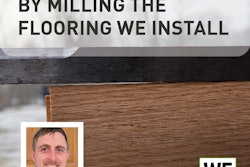The Problem
A few years ago, my crew and I were in Detroit installing a floor in a sporting goods store. The product was a 3/8-inch, 1-by-6-foot unfinished solid maple parquet to be glued on a concrete slab. We already had installed this same type of system in about 55 other stores, and this floor seemed to be going right on schedule. When the installation and the sanding were complete,we applied two coats of a waterborne sealer on about 2,500 square feet. Then came the finish,and that's when the problem became apparent. The instant we started to apply the finish, the flooring began to buckle up off the slab. It was 12:30 at night, and I didn't know why it was happening, so we continued applying the finish until that section was complete. I figured I would deal with it in the morning when the superintendent would be there.
The Procedure
This particular floor system is a specialty in and of itself. It comes in 1-by-6-foot panels made up of 1-by-12-inch finger-jointed slats with a 1/3 2-inch piece of foam separating the slats for expansion purposes. To install it, we glued starter rows down the length of the floor every 5 feet with a urethane adhesive. After the rows were set up, we installed the rest of the flooring in the "bay areas," which were the areas between the starter rows, always working to the center of the bay.
After the installation was complete, we sanded the floor and applied the first two coats of waterborne sealer. When we buffed the floor in preparation for the finish, the floor seemed fine. We then vacuumed the floor and tacked. About 25 minutes later, we began finishing with a lightweight T-bar and waterborne finish. Within minutes of the finish touching the wood, the floor began to buckle. By the time we finished the application, you could lift the hardwood off the slab in one giant piece.
The Cause
I knew we didn't do anything differently from the previous 55 floors like this one, and we didn't change any products. I began troubleshooting by backtracking through every step we took during the installation, sanding and sealing processes. Although the GC denied using a sealer on the concrete, I told him slab contamination was the only possible explanation. After about two hours of butting heads, he admitted that he had indeed used a sealer on the slab. In our contract, it specified that there could not be any sealers or contaminants on the slab. When the finish reached the slab, it reacted with the adhesive, causing the adhesive to release from the concrete.
How to Fix the Floor
Unfortunately, there was no way of fixing the installed flooring. The floor that buckled was about 2,500 square feet, and another unfinished 1,500 square feet had to be ripped out, as well. After the hardwood demolition, the next obstacle was getting the sealer off of the slab. A company was hired to come in with a heavy duty machine to shot blast the sealer off,removing about 1/8-inch of the concrete. Fortunately for us, we had a good contract and were not liable for any of the extra work.
In the Future
Although I was protected by our specs in the contract, it bothered me to know that this whole situation could have been avoided if I hadn't taken for granted that the GC would follow our specifications. Ever since that day, I have used a few different methods to test each slab before installing a wood floor. Generally, a slab with a sealer on it has a glossy sheen, making it easy to see. I say "generally," because this is not always the case. I also take a test piece of flooring and glue it down to test the adhesion before we start the actual installation process. Finally, I pour a small amount of water on the slab where the flooring is to be installed. If it beads up into little droplets of water (like raindrops on a vehicle that has been waxed), this indicates there probably is a sealer on it. If it absorbs into the concrete, it is free of a sealer.
Testing the substrate can be the most important step of the job. Oftentimes we are so concerned about our part of the job (acclimation, humidity, moisture content, job time, etc.) that we don't check the things that might affect our work. It was not my responsibility to check the slab for sealer, but as a professional, it is my job to know the consequences if I don't. Though this was an expensive lesson for the GC and an inconvenience for me (I had to drive all the way from New York to Detroit to do the job a second time), it was an invaluable learning experience.






























